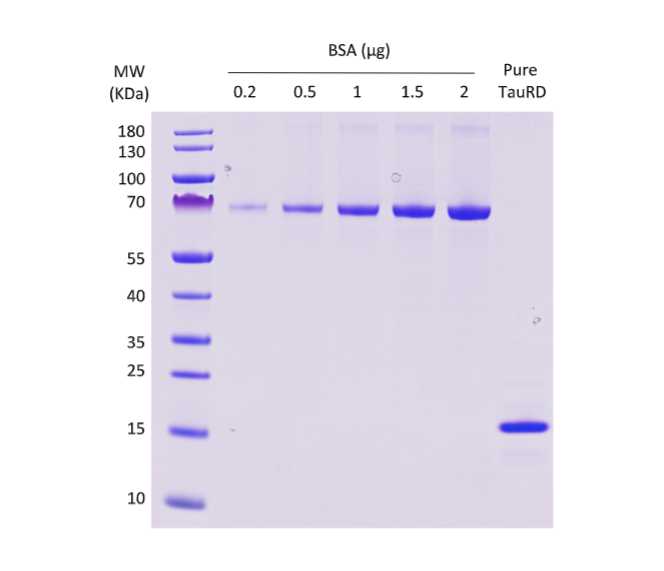Purification of recombinant Tau Repeat Domain (TauRD) from Escherichia coli
Patricia Yuste-Checa, F Ulrich Hartl
Abstract
This protocol details how to efficiently purify the recombinant Tau repeat domain from Escherichia coli.
Attachments
Steps
TauRD expression
Thaw RbCl-competent Escherichia coli Bl21 cells (DE3) On ice.
Add 1µL of pHUE-TauRD plasmid (His 6 -ubiquitin-TauRD) and incubate 0h 30m 0s On ice.
Heat shock 0h 0m 45s at 42°C.
Incubate On ice 0h 2m 0s, then add 850µL Lysogeny broth (LB) or Super Optimal broth with Catabolite repression (SOC) medium.
Shake for 1h 0m 0s at 37°C.
Centrifuge for 0h 5m 0s at 3000x g,0h 0m 0s and remove most of the supernatant.
Resuspend the pellet with the remaining supernatant and plate the bacteria on LB/Ampicillin agar plates and incubate 1h 0m 0s at 37°C.
Prepare preculture: Scrap all colonies with the scraper and inoculate 25mL-50mL LB/Ampicillin. Shake at 37°C for 4-6h 0m 0s.
Measure OD600 of the preculture and inoculate two flasks with 1L of TB media each to an
OD600 = 0.05.
Shake flasks at 37°C until approx. OD600 = 0.5-0.8. (2 - 4h 0m 0s)
Add isopropyl β-D-1-thiogalactopyranoside (IPTG) at final concentration of 0.4millimolar (mM).
Shake flasks 4h 0m 0s at 37°C.
Centrifuge bacterial culture at 4000rpm,0h 0m 0s for 1h 0m 0s. Discard supernatant. Cell pellets can be stored at -80°C.
Ni-NTA chromatography
Resuspend the cell pellets with lysis buffer (50mL lysis buffer/2L bacteria culture) supplemented with Complete EDTA-free protease inhibitor cocktail (Merck) and benzonase.
Add 1 lysozyme and incubate gently shaking for 0h 30m 0s at 4°C.
Sonicate lysate On ice, 5 cycles 0h 0m 30s ON, 0h 1m 30s OFF.
Centrifuge lysate at 40000x g,0h 0m 0s 1h 0m 0s at 4°C.
Prepare Ni-NTA column by transferring 10mL Ni-NTA resin slurry to a column (5mL column bed). Wash Ni-NTA column with 10 column volumes (CV, 50mL) water and equilibrate with 10 CV (50mL) lysis buffer.
Load lysate supernatant to Ni-NTA column.
Wash Ni-NTA column with 10 CV (50mL) high salt buffer and 10 CV (50mL) wash buffer.
Elute His 6 -ubiquitin-TauRD with 20mL elution buffer and collect everything.
His 6 -ubiquitin cleavage
Dilute eluted protein 1:5 with PIPES buffer to reduce the amount of salt (20mL eluted protein + 80mL PIPES buffer).
Incubate diluted His 6 -ubiquitin-TauRD protein with 0.5mg Usp2 ubiquitin protease at 4°C``1h 0m 0s.
Cation exchange chromatography
Load the cleavage mixture onto a Source S cation exchange column previously equilibrated with cation exchange buffer A.
Wash the column with 5 CV of cation exchange Buffer A.
Elute TauRD with a 0-500millimolar (mM) linear NaCl gradient in 50millimolar (mM) PIPES-NaOH 6.5, 2millimolar (mM) β-ME (0-50% gradient from cation exchange buffer A to cation exchange buffer B over 10 CV).
Analyze eluted fraction by SDS-PAGE and Coomassie blue staining.
Size exclusion chromatography
Load TauRD-containing fractions onto a Superdex-75 column previously equilibrated with PBS.
Analyze eluted fraction by SDS-PAGE and Coomassie blue staining.
Pool fractions containing TauRD, aliquot and flash-freeze in liquid nitrogen for storage at -80°C.


